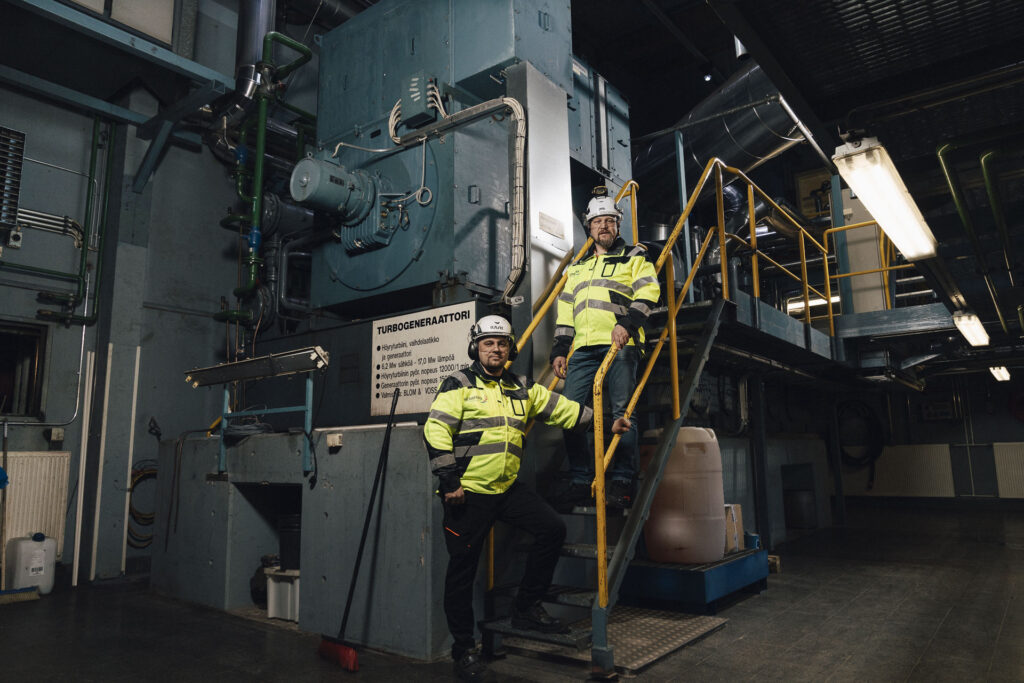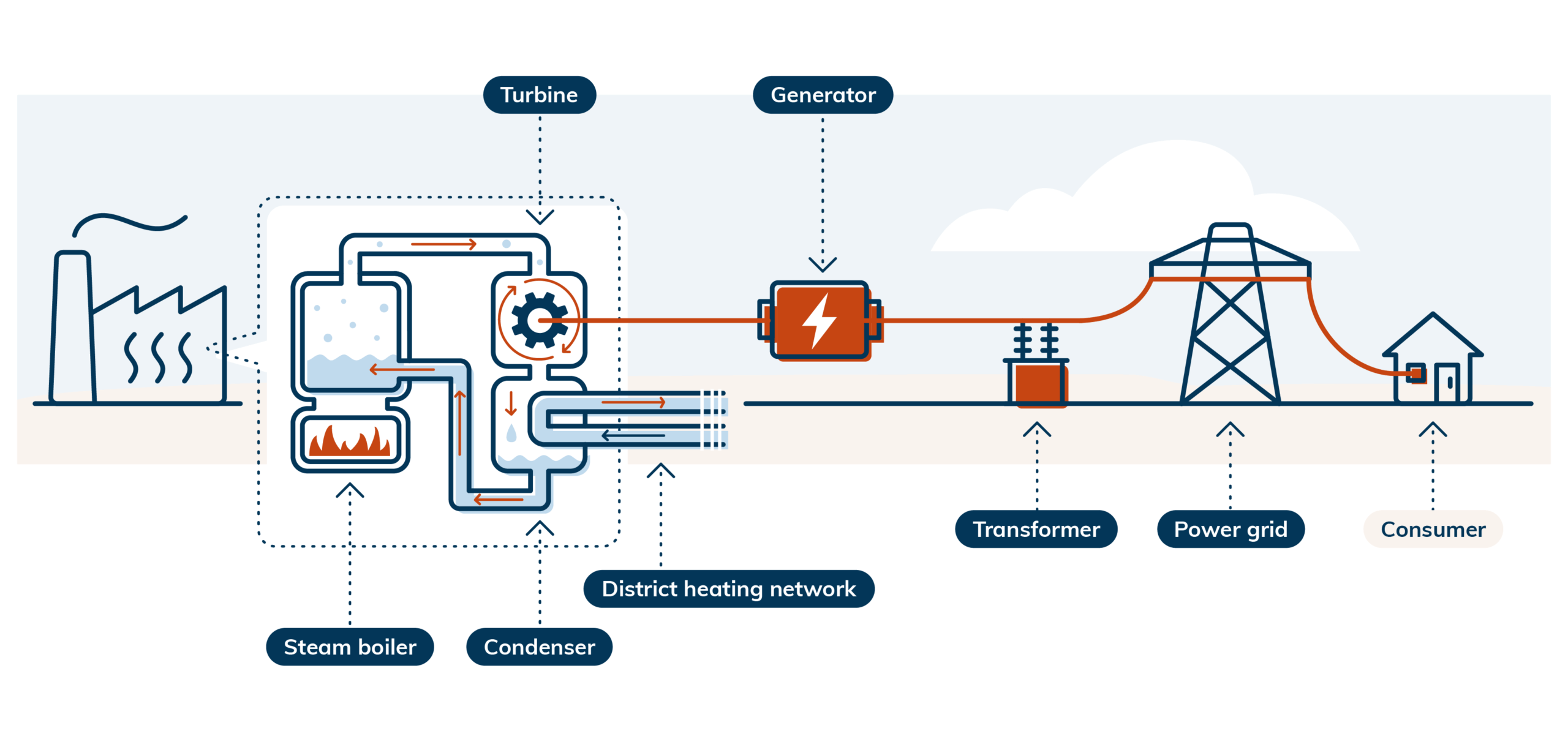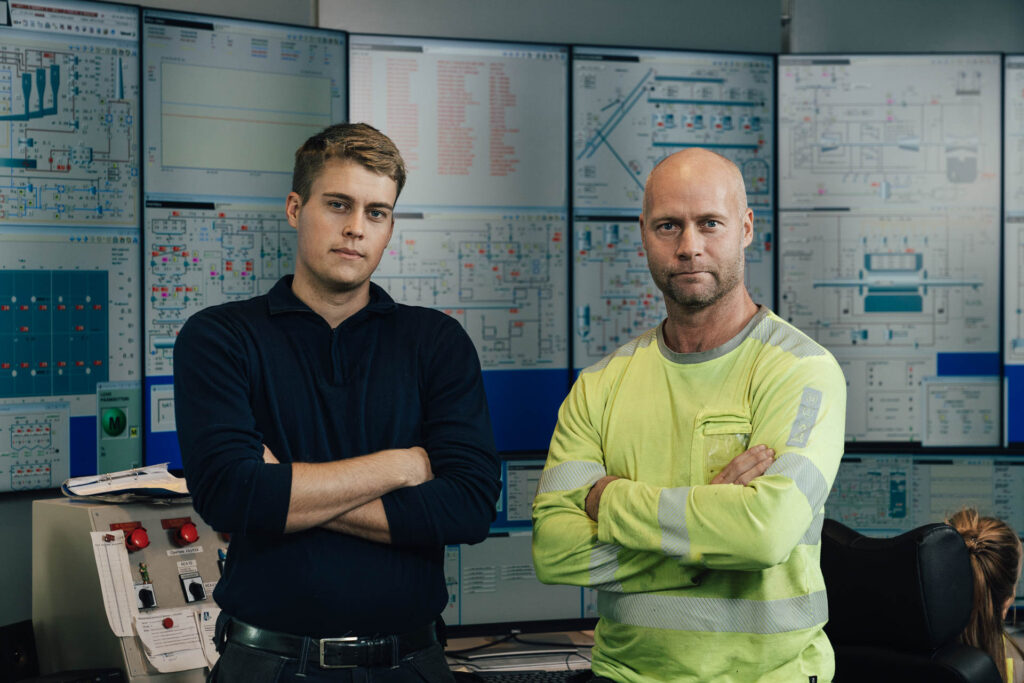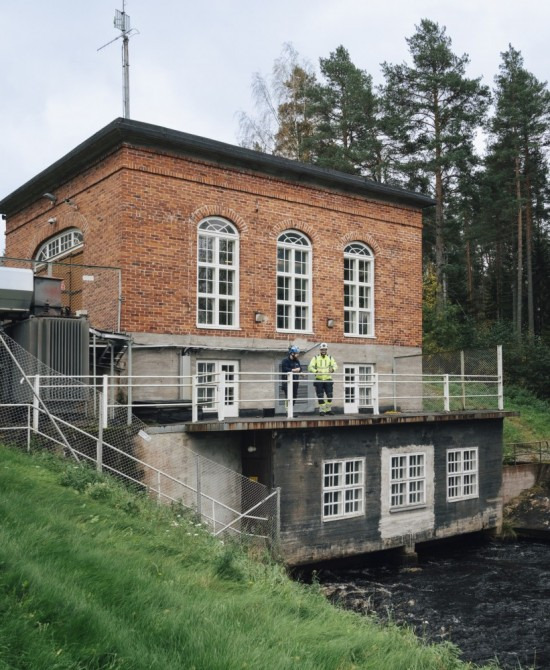Combined heat and power
Combined heat and power (CHP) has played an important role in Finland’s energy system since the mid-20th century. Most Finnish cities are heated with district heating, which comes from one or more CHP plants. A CHP plant can operate on almost any type of fuel. Today, the share of fossil fuels in CHP production is very small, and they are being phased out and replaced with biofuels.

Combined heat and power plants – produce both electricity and heat
A combined heat and power plant produces electricity, and the heat generated is transferred to the district heating system. This maximizes the use of the fuel. In addition, combined heat and power is a significant advantage for the energy system because electricity can be produced completely independent of weather and season.
Combined heat and power (CHP) has played an important role in Finland’s energy system since the mid-20th century. Most Finnish cities are heated with district heating, which comes from one or more CHP plants. A CHP plant can operate on almost any type of fuel. Today, the share of fossil fuels in CHP production is very small, and they are being phased out and replaced with biofuels.
Utilization of biofuels
A combined heat and power plant can use almost any type of fuel. The most common fuel is biofuel, which mainly comes from by-products of the forest industry, such as branches, treetops, bark, and wood chips.
Utilization of waste
Household or industrial waste can also be used as fuel, meaning waste that has not been recycled in other ways.
Reliable energy production in all conditions
Yhteistuotanto tarjoaa meille luotettavaa energiaa kaikissa olosuhteissa. Silloin kun tarvitsemme sähköä ja lämpöä eniten, eli talvella, kun on pimeää ja kylmää, yhteistuotantolaitokset tuottavat molempia luotettavasti.
How does combined heat and power work?
Fuel is used to heat a steam boiler, where the steam produced drives a turbine. The turbine is connected to a generator, which converts the kinetic energy into electrical energy. The heat generated at the same time is recovered and directed to the district heating network. The electricity is transmitted through a transformer to the power grid and then to consumers. This process efficiently produces both electricity and heat from the same energy source.


INVESTMENT
The importance of combined heat and power for Herrfors
Herrfors produces combined heat and power in partly owned CHP plants: Alholmens Kraft in Pietarsaari and Vieskan Voima in Ylivieska. These two power plants are very important for the company because they supply district heating to the cities. Thanks to its large electricity production capacity, Alholmens Kraft is also Herrfors’ largest single electricity production resource.
Fun facts
Facts about Herrfors’ combined heat and power production
Thermal power share 33.3%
In 2024, the share of thermal power in Herrfors’ electricity production was 33.3%. Thermal power produces electricity and heat efficiently and reliably, especially in winter. Herrfors focuses on renewable fuels instead of fossil fuels.
Investments in thermal power
Herrfors owns shares in several thermal power plants. The largest is Alholmens Kraft (240 MW, 50% ownership). Others include Vieskan Voima in Ylivieska, Raahen Voima, and Tornion Voima.
Sustainable production
Vieskan Voima has reduced emissions by 85% by utilizing flue gas heat recovery. The plant uses biofuels such as sawdust and bark.

Vieskan voima
Rakennusvuosi: 1994
Teho: 6.5 MW
Herrforsin omistusosuus: 25.3%
Tornion voima
Rakennusvuosi: 2007
Teho: 37 MW
Herrforsin omistusosuus: 1%
Raahen Voima
Rakennusvuosi: 2016
Teho: 125 MW
Herrforsin omistusosuus: 0.1%
Ahlholmens Kraft
AK1
Rakennusvuosi: 1991
Teho: 25 MW
Herrforsin omistusosuus: 50%
AK2
Rakennusvuosi: 2001
Teho: 240 MW
Herrforsin omistusosuus: 50%
Here are the locations of Herrfors’ thermal power plants
Thermal power plant in which Herrfors is the majority owner:
Alholmenskraft: AK 1, AK 2
Thermal power plant in which Herrfors owns a minority share:
Vieskan voima, Tornion Voima, Raahen Voima
Benefits and challenges of combined heat and power
Combined heat and power is an important part of Herrfors’ responsible electricity production. Like all forms of energy production, combined heat and power also has both advantages and challenges. Below are the key points.
Benefits of combined heat and power
- Utilization of biofuels
A combined heat and power plant can use almost any type of fuel. The most common fuel is biofuel, which mainly comes from by-products of the forest industry, such as branches, treetops, bark, and wood chips. - Utilization of waste
Household or industrial waste can also be used as fuel, meaning waste that has not been recycled in other ways. - Reliable energy production in all conditions
Combined heat and power provides us with reliable energy in all conditions. When we need electricity and heat the most, in winter when it is dark and cold, CHP plants reliably produce both.
Challenges of combined heat and power
- Profitability challenges during summer
The more district heating that is produced, the more electricity can be generated from combined heat and power, which is an advantage during the winter months when the demand for light, heat, and hot water is highest. On the other hand, during the warmer season, situations may arise where the demand for district heating decreases and the price of electricity drops, making operations unprofitable. - Formation of air pollutants
When we burn fuels in a combined heat and power plant, air pollutants such as hydrocarbons, nitrogen oxides, and particles are produced.
Frequently asked questions
Here you can find answers to the most frequently asked questions about combined heat and power.
CHP means that both electricity and heat are produced in the same production process. Herrfors uses CHP efficiently to meet the region’s needs for electricity and district heating.
Various fuels can be used in CHP production, such as wood, biofuels, peat and sometimes even waste. Herrfors works continuously to reduce the share of fossil fuels by replacing peat with renewable alternatives and by optimising processes.
In 2024, combined heat and power production (thermal power) accounted for about 33.3% of Herrfors total electricity generation.

Choose Renewable Electricity – Easy and Responsible
With Herrfors’ Renewable Choice electricity contract, you are guaranteed that the electricity you consume is produced from 100 % renewable energy sources. You can make a climate-friendly choice without compromising on everyday comfort. Renewable Choice is available for all our contract types – pick the one that suits you best and make a sustainable decision.
- 100 % renewable electricity (wind, water, bioenergy)
- Verified origin with Guarantees of Origin
- Local and responsible energy production

More information about our electricity production methods
Herrfors’ main electricity production methods are hydropower, wind power, thermal power, and nuclear power. Read more about other electricity production methods in the articles below.